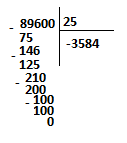The difficulty of calculating school math examples
This calculator gives an estimate of the difficulty of calculating math examples. It can be used for comparative estimation of the difficulty math problems.
This calculator tries to estimate the difficulty of calculating without a calculator (on a piece of paper) problems using the arithmetic operations of addition, subtraction, multiplication and division.
The calculator determines the number of elementary operations in the example and gives a conditional difficulty expressed in milliseconds required to calculate the example. The difficulty is the sum of the elementary operations multiplied by the difficulty factor (the time in milliseconds required to perform the operation). The elementary operations are explained in the table at the bottom of the calculator.
Decoding of operations with difficulty .
++ difficulty 200, increase by one, for example, when multiplying 200*3000 - there will be one multiplication 2*3 and counting zeros 5 times.
+ difficulty 500, elementary addition e.g. 5+4
- difficulty 500, elementary subtraction e.g. 3-2
* difficulty 1000, elementary multiplication, e.g. 2*2
/ difficulty 1000, division - the operation of division is reduced to successive operations of multiplication and subtraction, at that we estimate each time what multiplier should be chosen to make the product slightly less or equal to the current divisor. This elementary operation is counted in this column. The necessary multiplications and subtractions are counted additionally.
0+ difficulty 100, addition with zero - the special case is highlighted separately because it is a simpler operation than addition.
0 difficulty 100, zero substitution.
°+ difficulty 700, addition with unit carry, e.g. 16+7 - contains two operations - elementary addition and unit carry to the next digit.
=0 difficulty 200, reduction - operations of subtraction of equal values, e.g. 100-100
°- difficulty 600, borrow a unit when subtracting, e.g. subtracting 11-9 will perform one borrow and one subtraction operation.
** difficulty 400, repeated multiplication. it often happens that when performing elementary ( and not only ) multiplication operations, the same operations are performed. For example 25*33 will contain two elementary multiplications and one repetition, we can simply rewrite the result of multiplying 25*3 one more time.
*0 difficulty 100, special case of multiplication by zero
*1 difficulty 200, special case of multiplication by one
°** difficulty 700, carry when multiplying, e.g. 23*4 is two elementary multiplications plus one carry (1) when multiplying 3*4
+- difficulty 300, change of sign
<> difficulty 500, transposition of subtraction, performed if we try to subtract from less to more.
. difficulty 500, floating point operations
Let's consider the calculation of difficulty using the example (4567+987-8354)*32/25:
The example contains all four arithmetic operations.

First, the addition 4567+987=5554 is performed
As you can see, there are three elementary additions in this example: 7+7, 6+8, 5+9, each of which performs a unit transfer to a higher digit.

Subtraction 5554-8354=-2800
Since a larger number is subtracted from a smaller number, the result is negative, the operands are permuted before subtraction. The first two digits of 5,4 are reduced, then when calculating 3-5, elementary subtraction with borrowing a unit is performed, then just subtraction 8-1-5=2.

The third action is multiplication -2800*32=-89600
Since the first multiplier ends with zeros, we perform a count of them so that we can add the zeros to the result at the end of the multiplication. We then multiply by 28*32. When multiplying by 3*8 and 2*8, a carryover to the next digit is performed. 2*2 and 2*3 are just elementary multiplications. Total 4 elementary multiplications, 2 transfers, 2 counting.

The last action is division -89600/25=-3584
At each division step, a multiplier is selected so that the product of the multiplier by the divisor is close to the number made up by the first digits of the current remainder of the division. This operation is counted as elementary division, after which multiplication and subtraction are performed, the complexity of which is calculated analogously to the previous steps.
In particular, when dividing the first digits of (86) by 25, we choose multiplier = 3. Then multiplication 25*3-75 is performed, then subtraction 89-75=14.
Total when calculating 89600/25 we have: 4 divisions and 4 subtractions, 8 products, 3 reductions, two multiplications with carry, in multiplication with carry there is one addition.
In the end, 52 elementary operations are performed during the calculation of the whole example - taking into account the indicated weighting factors, the total complexity is 28500. Thus, it will take about half a minute (28.5 seconds) to solve this example.
P.S. All time estimates and the difficulty calculation algorithm itself are based on the author's subjective assumptions, comments and remarks are welcome.
Comments